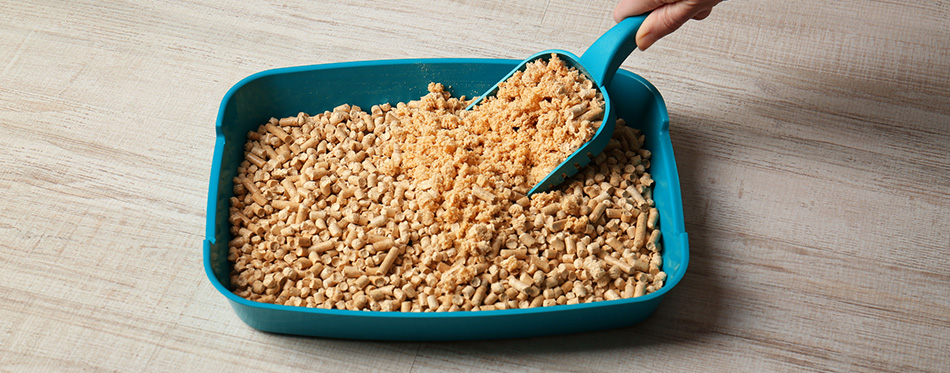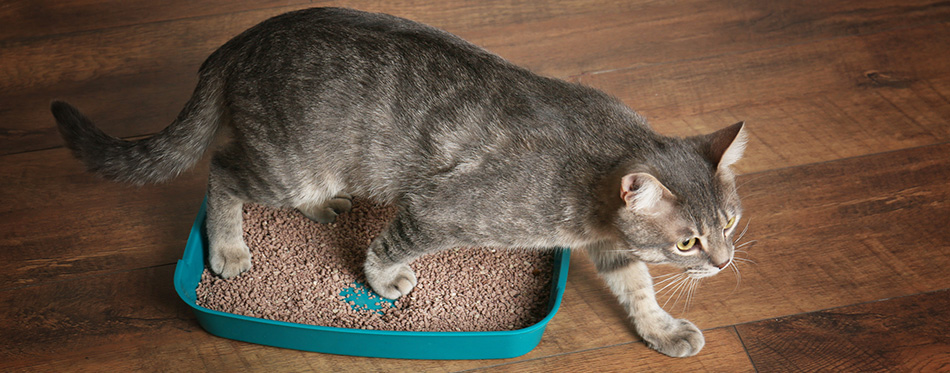If you keep your cat indoors, one of the most challenging parts is keeping their litter box under control. One of the most unpleasant parts of this is managing the smells – particularly if you live in a small house or apartment where it is difficult to escape them. But there are some management techniques that you can use to reduce the problem, and these are what we are going to talk about in this blog post to help offer advice on how to get rid of cat litter smells.

How To Keep a Litter Box from Smelling
- Choose the right spot
If you can choose a spot behind a closing door, this is obviously going to give you the best shot at controlling litter box odor. Some people choose to put a cat flap on the door, so they are not left having to open and close every time their kitty wants to use the bathroom. If you are not able to put it behind a closing door, choose a spot that is as far away from your general living area as possible.
- Scoop the box at least once a day
The most obvious advice that we can give is that you should scoop the box at least once a day. Not only is this important in managing the litter box smell, but it is also essential for your cat’s personal hygiene. Just imagine when you step into a bathroom and find it in dirty and disgusting conditions. It is just as unpleasant for your cat to deal with and they may even look for somewhere else to go, which is certainly not going to improve the smell situation in your abode! The longer your cat’s litter box is left unchanged, the quicker the smells will start drifting into the rest of the house. If you have a bit more to spend and don’t want the hassle, you could invest in an automatic scooping box. However, these have the downside of being quite intimidating to cats, and they may be put off using it if they are particularly fearful. Find out more about self-cleaning litter boxes here.
- Replace the litter twice a week
Even if you are keeping on top of the scooping, this won’t leave the box entirely clean and you are likely to miss some. And over time, even small amounts of pee and poop can start to smell. This is why it is best that you replace the litter at least twice a week. Remember, if you have multiple cats, you should have multiple litter trays for them to use.
- Clean the litter box thoroughly
You should also clean the box itself on a regular basis, making sure that you wear gloves to prevent anything unpleasant from getting on your hands, which could cause health issues to yourself. You can just use soap and water to clean the box as the smell of bleach and harsh chemicals can end up putting your cat off from using it at all. Once the box has been properly dried, you can then add some fresh litter once again. For a wider selection of choices, check out our cat litter guide.
- Replace the litter box once a year
Even with all the scooping and cleaning, you should still replace the box on an annual basis. This is largely down to the fact that the action of scooping and your cat’s claws can make grooves in the box, which are harder to sterilize and means that odors are more likely to stick around. If you don’t want to throw the box away, you could always donate it to a shelter or rescue group. You may decide to get the same or a similar style to the previous box to keep a sense of consistency so that your cat doesn’t have to keep getting used to something entirely new.
- Use litter deodorizers
A product that is designed specifically for this task, you could try using a litter box odor eliminator to make the smell more pleasant around your cat’s litter box. Or a simple DIY solution with something that you already have in your home is to sprinkle down some baking soda. Bear in mind that some cats will steer clear of litter boxes that are too heavily scented, so you need to choose one that is agreeable to both you and your feline. Every time you scoop the box, you should sprinkle some of the deodorizer over the top.
- Choose the right brand
Select the brand of litter carefully. Bear in mind that the cheaper ones may not have the same odor-controlling abilities than if you go for something at the more expensive end of the scale. You should also choose one that smells the most pleasant to you. Be wary of continually changing your cat’s litter as this can put them off wanting to go in the box, and they may find somewhere else that is altogether less pleasant!
- Select a well-ventilated area
Many cat owners are tempted to hide the litter box away as much as possible in a dark closet. But this keeps the odor concentrated in a single space, so you are likely to notice the unpleasant ‘blast’ every time you open the door. Again, this could make the area too smelly for your cat to tolerate, and they could find an alternate environment. Choose a spot which is well-ventilated as this will allow the scents to disperse more easily. If you can open a window from time to time, this is even better.
You may also like our article on Cat Litter Mats.

Final Thoughts
Keeping your cat’s litter box free of odors is a worthwhile task for both you and your kitty. Neither one of you will appreciate bad smells in this area. Hopefully, a combination of the tips that we have listed here will help you with this task. Bear in mind that you still need to keep a sense of consistency in the cleaning method you use, the type of litter, etc. Otherwise, your cat may be put off from using it, and this will have the opposite effect to the one you were intending!

